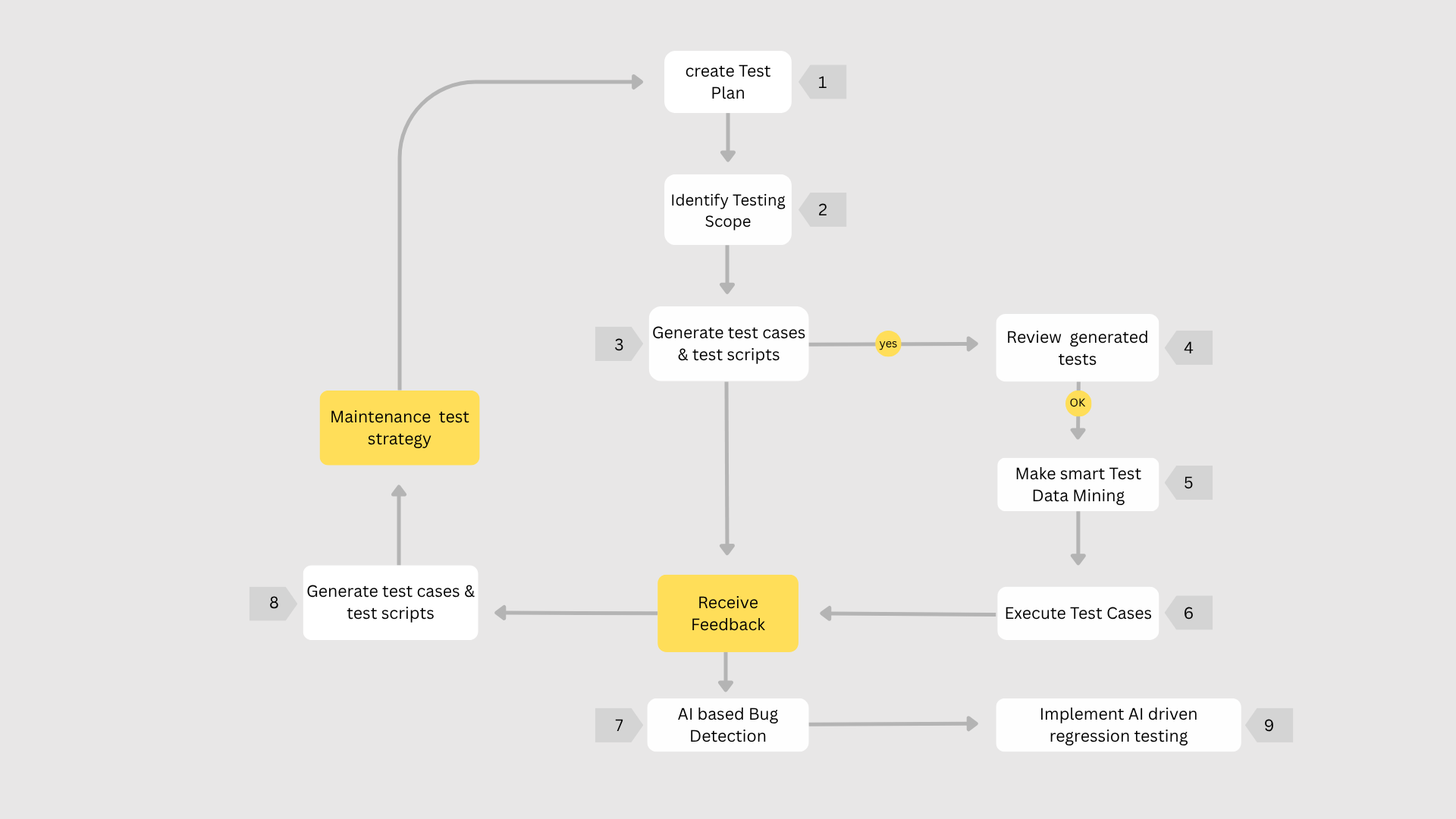AI-Based Mobile Testing: How to Use It Effectively
Introduction
AI is transforming the landscape of mobile app testing by making the process faster, smarter, and more efficient. Traditional manual testing and static test cases often fall short when it comes to speed, scalability, and accuracy. AI-powered tools are changing that automating the creation of test scripts, predicting and detecting bugs early, managing test data more effectively, and even analyzing user behavior to improve app usability. By integrating AI into your mobile testing strategy, you can streamline workflows, reduce time-to-market, and deliver a more reliable user experience. In this post, we’ll explore key ways to use AI effectively in mobile testing.

Get the Mobile Testing Playbook Used by 800+ QA Teams
Discover 50+ battle-tested strategies to catch critical bugs before production and ship 5-star apps faster.
Understanding AI-Driven Mobile Testing Workflow
The diagram above shows how artificial intelligence fits into modern mobile app testing. Let’s explore each part of this process and understand how it works in real-world testing:

1. Automatically Create Test Scripts with AI
One of the most useful benefits of AI in mobile testing is that it can automatically write test scripts for you. These scripts are based on new features added to the app, updates in functionality, or specific user requirements.
Here’s how the process usually works:
First, you explain what the app should do. For example, “Add an item to the cart” or “Make a payment.”
You feed these requirements to the AI model.
The AI reads and understands your goal and starts generating test cases.
You then review these AI-generated cases and give feedback.
The process continues until the AI delivers test cases that fully match your needs.
This saves a lot of time and effort, especially when testing apps with frequent updates.
2. Catching Bugs Before They Break Things
AI can also predict where bugs might appear, even before they happen. By analyzing old testing data, AI spots patterns and identifies risky parts of the app that need more attention.
Here’s how it works:
The AI reviews past testing results and looks at things like what failed, where, and why.
That data is cleaned and organized to make it useful for learning.
AI then uses that information to understand what issues to expect in future versions of the app.
After being trained properly, the AI can analyze new app versions and raise alerts about possible bugs.
Think of it as your app’s early warning system.
3. Real-Time Feedback and Test Analysis
Instead of waiting until the end of testing, AI tools give you updates as tests run. This means you can fix issues sooner and avoid long delays.
To use it:
Pick an AI testing tool that suits your needs.
Add it to your testing system.
Run your tests, and the tool will track results instantly.
You’ll get detailed insights like which tests are flaky (inconsistent), how many failed, and where to focus next.
It helps teams move faster and make better decisions.
4. Smarter Test Data with AI
You don’t need huge amounts of real user data anymore. AI can create smart, fake data that behaves like real users would. It can also hide sensitive data to ensure privacy while testing.
AI test data helps by:
Generating both successful and failing scenarios that resemble real-life situations.
Creating new data on the fly, instead of storing large datasets.
Reducing the need to manually write or collect test data.
This makes testing easier and safer.
5. Improving App Usability with AI
AI tools can watch how people use your app and find areas where users might struggle. This gives your team feedback to improve the design and user experience.
Here’s what to do:
Choose an AI testing tool that includes usability tracking.
Add it to your app testing process.
Use the insights to discuss and fix any issues that could affect the user journey.
When you test how real users interact with your app, you can improve it for everyone.
Best Practices for Using AI in Mobile App Testing
AI is significantly enhancing how mobile test automation is performed today. It brings speed, intelligence, and adaptability to testing processes, helping teams work more efficiently. However, to truly benefit from AI in mobile testing, it’s important to apply it thoughtfully. Here are some best practices to help your team get the most out of AI-powered mobile testing:
1. Choose the Right AI Testing Tools
Start by identifying AI-powered testing tools that match the specific needs of your mobile application. Different tools offer different capabilities from automated test generation and bug prediction to real-time reporting and usability analysis. Ensure the tool you pick can handle a range of testing tasks and is compatible with your tech stack and platforms (iOS, Android, cross-platform).
2. AI Is a Partner, Not a Replacement
AI does not replace your QA team, it enhances their capabilities. It’s important to see AI as a supportive technology that can handle repetitive and data-heavy tasks, allowing your testers to focus on areas that require human insight. The real power lies in the collaboration between your QA professionals and AI tools.
3. Combine Manual Testing with AI Automation
While AI can automate many parts of testing, not everything can or should be automated. Some testing scenarios especially those involving user experience, edge cases, or creative problem-solving still benefit from human intuition and expertise. A balanced approach that includes both manual and AI-driven testing ensures broader and more accurate test coverage.
4. Don’t Rely Solely on AI-Generated Test Cases
AI can efficiently generate test cases based on historical data and user behavior patterns, but human input is still vital. QA teams should regularly review, refine, and contribute to the test cases to ensure they align with real-world use cases and business needs. A hybrid approach leads to more meaningful and reliable testing outcomes.
5. Leverage Visual AI for UI and UX Testing
Mobile apps run across a wide range of devices with varying screen sizes, resolutions, and operating systems. Visual AI tools are particularly useful in this context; they can automatically detect visual bugs, layout shifts, or UI inconsistencies across different devices. Incorporating visual AI testing helps ensure that your app looks and behaves as expected, regardless of where it’s being used.
Final Thoughts
In today’s fast-paced mobile development environment, relying solely on traditional testing methods is no longer enough. AI-powered mobile testing has become a crucial component for teams aiming to release high-quality apps faster and more efficiently. It empowers teams to streamline repetitive testing tasks, uncover bugs earlier in the development cycle, and improve the overall user experience.
When implemented wisely, AI not only accelerates the testing process but also enhances precision and scalability, two factors that are vital as applications grow in complexity.At Quash, we help teams harness the full potential of AI in mobile testing. Our platform empowers QA teams to move faster without compromising on quality, offering AI-driven insights, automated test creation, real-time reporting, and more.
Embracing AI with the right tools like Quash isn't just about keeping up, it's about setting a higher standard for mobile app quality and user satisfaction.





